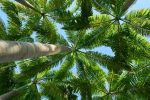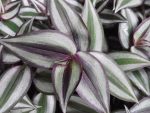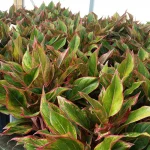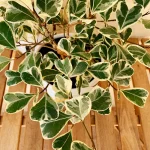This post contains affiliate links. If you buy something from one of our links we may earn a commission. Thanks
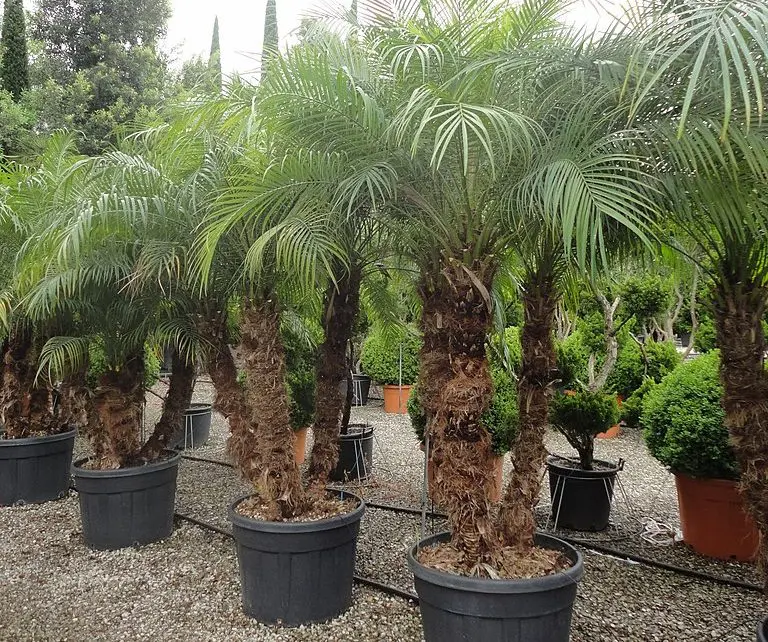
Learn the best practices for pygmy date palm indoor care to keep your tropical plant healthy and beautiful. Our expert tips cover soil, watering, propagation, and more.
I. Introduction To Pygmy Date Palm Indoor Care
Pygmy Date Palm indoor care entails providing bright indirect sunlight, regular watering allowing the top inch of soil to dry out between waterings, and a well-draining soil mix like a 50/50 mix of coco coir and perlite.
It thrives in temperatures between 70-80°F (21-27°C) during the day and 60-70°F (15-21°C) at night with a humidity level of 50-60%.
Fertilize every 2-3 months during the growing season with slow-release fertilizers or palm-specialized fertilizer spikes. Repotting every 2-3 years or when it outgrows its pot ensures continued growth.
With its lush green leaves and compact size, the Pygmy Date Palm is a popular choice for indoor gardening.
However, even though it’s a relatively low-maintenance plant, it still requires some attention to thrive.
Proper pygmy date palm indoor care includes providing the plant with the right amount of water, humidity, and bright indirect light.
In addition, choosing the right soil and pot for your dwarf date palm is also essential for its well-being.
By following these care tips, you can ensure that your Pygmy Date Palm remains healthy and vibrant for years to come.
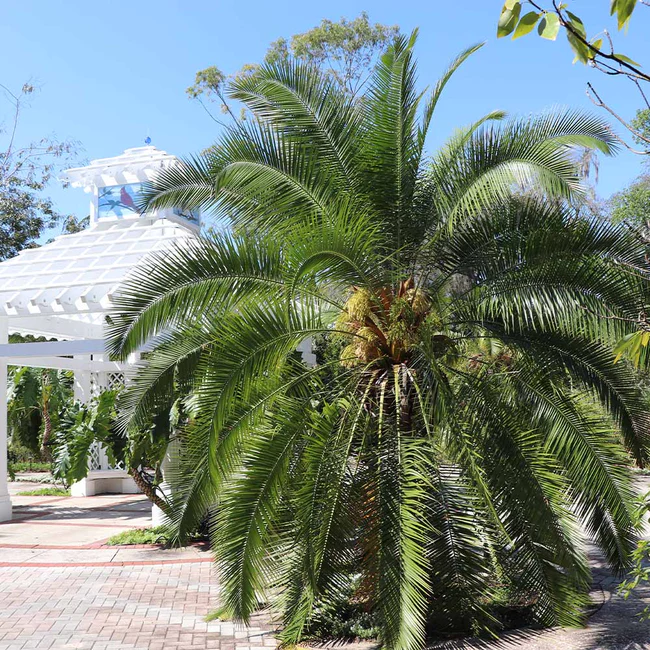
Pygmy Date Palm Quick Facts
| Mature Height: | 6-7 ft Indoors 7-12 ft Outdoors |
| Mature Width: | 3-5 ft Indoors 3-5 ft Outdoors |
| Sunlight: | Full-Partial |
| Growth Rate: | Slow |
| Botanical Name: | Phoenix roebelenii |
| Grows Well In Zones: | 4-11 patio / 10-11 outdoors |
Get your Pygmy Date Palm at Fast Growing Trees
A brief overview of the Pygmy Date Palm plant
The Pygmy Date Palm botanical name is Phoenix roebelenii, which is a small, slow-growing dwarf palm tree that is native to Southeast Asia.
It features graceful, feathery fronds that emerge from a slender trunk and can grow up to 6-10 feet in height.
Pygmy Date Palm trees are a popular houseplant and adds a touch of tropical flair to any indoor space.
You probably won’t get dates from your tree because you need male trees and female trees to get dates and the female flowers would need to be hand pollinated but this beautiful tropical palm is definitely still worth keeping.
Importance of indoor care for the Pygmy Date Palm
While the Pygmy Date Palm is relatively easy to care for, it still requires specific conditions to thrive indoors.
The plant needs the right amount of sunlight, water, and humidity to remain healthy and vibrant.
Neglecting these requirements can lead to stunted growth, wilting, or even death.
Preview of the topics to be covered
In this post, we’ll cover all the essential topics related to pygmy date palm indoor care.
We’ll begin by discussing the plant’s lighting needs, including the best types of lighting for indoor plants and how to ensure your Pygmy Date Palm receives the right amount of light.
Next, we’ll dive into watering, soil, and pots, and explain how to choose the right soil and pot for your plant and how to water it properly.
We’ll also cover temperature and humidity requirements, fertilization, propagation, pests and diseases, and repotting.
By following these care tips, you can keep your Pygmy Date Palm healthy and thriving, adding a lush touch of the tropics to your indoor garden.
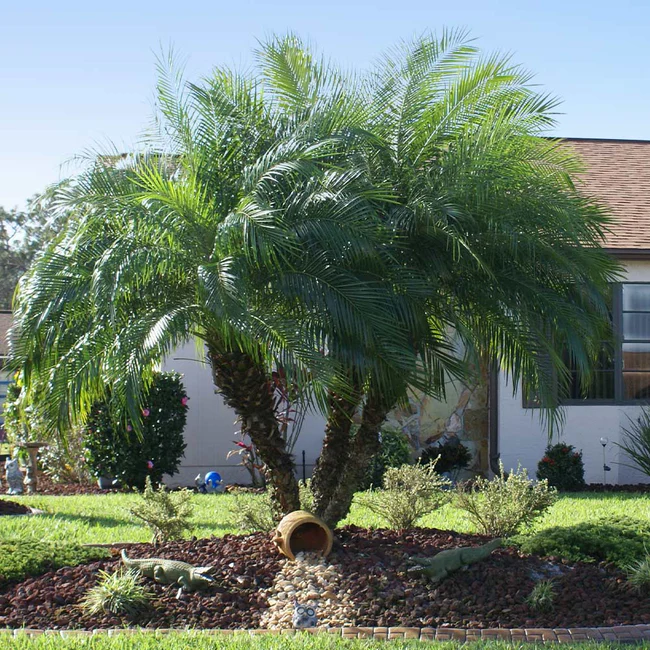
II. Light Requirements
Proper lighting is crucial for the health and growth of your Pygmy Date Palm. As a tropical plant, it requires bright but indirect sunlight to thrive indoors.
Insufficient light can cause the plant to become weak and spindly, while too much full sun can scorch the fronds.
In this section, we’ll discuss the different types of lighting that are suitable for indoor Pygmy Date Palms and how to ensure your plant receives the right amount of light.
Importance of proper lighting for the Pygmy Date Palm
Proper lighting is crucial for the Pygmy dwarf date palm’s health and growth.
The plant requires bright indirect sunlight to thrive indoors. It can tolerate some partial shade but not too much.
Without enough light, the plant’s fronds may become weak and spindly, and the plant may grow slowly or not at all.
Inadequate light may also cause the plant to develop brown spots or yellowing fronds.
On the other hand, too much direct sunlight can scorch the fronds, leading to permanent damage.
Types of lighting needed for indoor plants
There are three main types of lighting needed for indoor plants: natural light, fluorescent lights, and LED lights.
Natural light is the best option for Pygmy Date Palms, as it provides the full spectrum of light the plant needs. Fluorescent lights are a good alternative.
LED lights are more energy-efficient, emit less heat, and last longer than fluorescent lights.
Additionally, LED lights can be designed to produce a spectrum of light that closely mimics natural sunlight. This makes them an excellent choice for indoor plant growth, including for Pygmy Date Palms.
Tips for providing the right amount of light for the Pygmy Date Palm
To provide the right amount of light for your Pygmy Date Palm, it’s important to consider the plant’s natural habitat.
In the wild, the plant grows under the canopy of larger trees, which provide bright but indirect light.
Mimic these conditions by placing your plant near a north or east-facing window, where it can receive bright but filtered light.
You can also supplement natural light with fluorescent or LED lights to provide the plant with additional light.
Be sure to monitor your plant for signs of too much or too little light and adjust its location or lighting as needed.
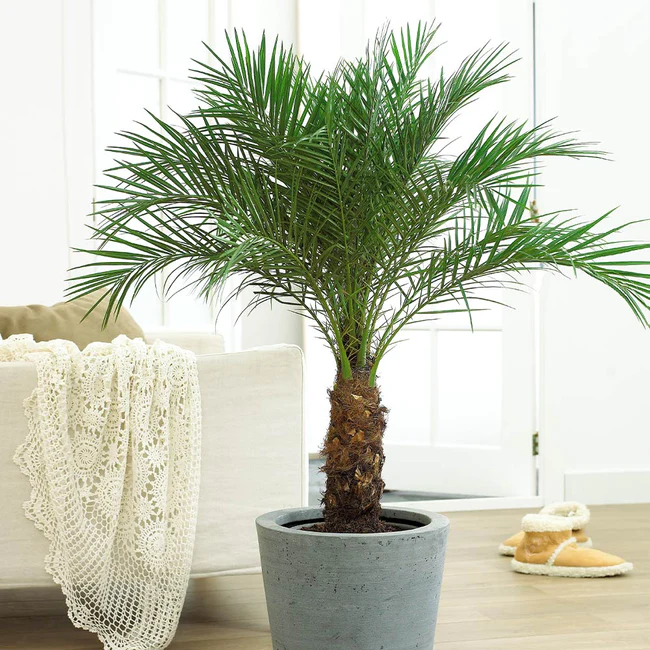
You can buy your dwarf pygmy date palm here
III. Watering
Proper watering is essential for the health of your Pygmy Date Palm.
As a tropical plant, it requires a consistent and appropriate amount of water to thrive indoors.
Overwatering can lead to root rot, while underwatering can cause the plant to become dehydrated and dry out.
In this section, we’ll discuss the ideal watering frequency and techniques for your Pygmy Date Palm, as well as how to determine when it’s time to water your plant.
Importance of proper watering for the Pygmy Date Palm
Proper watering is crucial for the Pygmy Date Palm’s health and growth.
As a tropical plant, it requires regular watering to maintain its lush appearance and prevent dehydration.
However, too much water can lead to root rot and other issues, while too little water can cause the plant to dry out and suffer.
By providing the appropriate amount of water, you can ensure that your Pygmy Date Palm thrives in its indoor environment.
Signs of overwatering and underwatering
Signs of over-watering in Pygmy Date Palms include yellowing or brown fronds, mushy or rotten roots, and a musty odor emanating from the soil.
Signs of under-watering include brown, crispy fronds, drooping leaves, and dry soil. It’s important to pay attention to these signs to prevent damage to your plant.
Tips for watering the Pygmy Date Palm
When watering your Pygmy Date Palm, it’s important to do so consistently on a regular basis and with the right amount of water.
Allow the top inch of soil to dry out before watering, and water thoroughly until water drains out of the bottom of the pot.
Avoid letting the plant sit in standing water, as this can lead to root rot.
Depending on the environment, you may need to water your plant every one to two weeks.
Additionally, it’s important to adjust your watering frequency based on the season and the size of the plant.
With these tips in mind, you can keep your Pygmy Date Palm healthy and vibrant for years to come.
Problems using tap water instead of distilled water
Using tap water instead of distilled water can be a problem for Pygmy Date Palms and other indoor plants.
Tap water often contains high levels of minerals and chemicals, such as chlorine and fluoride, that can be harmful to the plant’s root system over time.
These minerals can accumulate in the soil and cause root damage, which can lead to stunted growth, yellowing leaves, and other health problems for the plant.
Using distilled water can help to prevent these issues, as it is free from these harmful minerals and chemicals.
Alternatively, using a water filtration system can also be effective in removing harmful minerals from tap water.
In general, it’s a good practice to avoid using tap water on your Pygmy Date Palm and instead opt for distilled water or other purified water sources.
This can help to ensure that your plant remains healthy and vibrant, free from the damaging effects of tap water.
IV. Soil and Pots
The soil and pot that you choose for your Pygmy Date Palm can have a significant impact on its growth and overall health.
Choosing the right soil and pot can ensure that your plant has the proper drainage, nutrients, and space to thrive in an indoor environment.
In this section, we will explore the importance of selecting the right soil and pot for your Pygmy Date Palm, as well as provide tips and guidelines for selecting and caring for these crucial components.
Importance of proper soil and pot selection for the Pygmy Date Palm
Choosing the best soil and pot is crucial for the proper growth and health of your Pygmy Date Palm.
The right soil will provide essential nutrients, proper drainage, and the right amount of moisture retention, all of which are vital for the plant’s growth.
The right pot size is also important to ensure that the plant has enough space for its roots to grow and that it is not root-bound.
Choosing the wrong pot size can restrict the growth of the roots and stunt the overall growth of the plant.
Ideal soil types and pot sizes for the Pygmy Date Palm
Pygmy Date Palms thrive in well-drained soil, such as a mix of peat moss and perlite, or a high-quality potting soil mixed with sand.
It requires moist soil but also one that is well-drained.
I prefer a 50/50 mix of coco coir and perlite. Sand makes for a heavy container plant and coco coir is much lighter.
It is also a renewable resource with excellent water-holding capacity and drainage that is superior to peat moss.
The ideal pot size for a Pygmy Date Palm depends on the size of the plant and its growth stage.
For a small plant, a pot with a diameter of 6 to 8 inches is ideal, while larger plants may require a pot with a diameter of up to 14 inches.
Tips for selecting and preparing soil and pots for your Pygmy Date Palm
When selecting soil for your Pygmy Date Palm, make sure to choose a high-quality mix that is free from pests, diseases, and weed seeds.
Before planting, it’s important to prepare the pot by filling it with a layer of gravel or small stones at the bottom to improve drainage and prevent soggy soil.
Additionally, it’s a good idea to add a slow-release fertilizer to the soil mix to provide essential nutrients to the plant.
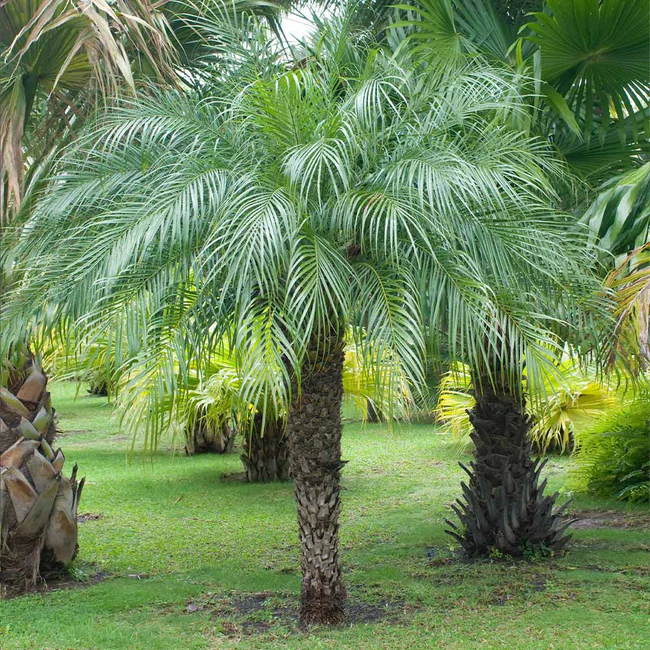
V. Temperature and Humidity
Proper temperature and humidity levels are crucial to the health and well-being of Pygmy Date Palms.
These tropical plants require warm temperatures and high humidity to thrive, which can be challenging to achieve in indoor environments.
In this section, we will discuss the ideal temperature and humidity range for Pygmy Date Palms and provide tips for maintaining these conditions in your home.
Importance of proper temperature and humidity for the Pygmy Date Palm:
Pygmy Date Palms are tropical plants and require warm temperatures and high humidity to thrive.
Proper temperature and humidity levels are essential to the plant’s growth and overall health.
If the temperature or humidity levels are too low or too high, the plant may become stressed, which can lead to a variety of problems, including slow growth, wilting, and susceptibility to pests and diseases.
Ideal temperature and humidity levels for the Pygmy Date Palm:
Pygmy Date Palms prefer a temperature range between 70-80°F (21-27°C) during the day and 60-70°F (15-21°C) at night.
They can be grown outdoors in USDA zone 10 and 11 where temperatures don’t go below 30.
In cooler climates, pygmy palm trees should be grown indoors as container plants. They can be moved outdoors during the summer months.
These plants prefer a humid environment. The ideal humidity level for these plants is between 50-60%. It’s essential to maintain consistent temperature and humidity levels, as fluctuations can be stressful for the plant.
Tips for regulating temperature and humidity in your home:
To maintain the ideal temperature and humidity levels for your Pygmy Date Palm, you can use a combination of heating, cooling, and humidifying devices.
Place the plant in a location with consistent temperatures and avoid placing it near drafts or heating vents.
To increase humidity levels, you can use a humidifier or place a tray of water near the plant.
It’s also important to regularly mist the plant with a spray bottle of room-temperature water to keep its leaves moist.
VI. Fertilization
Fertilization is an essential aspect of Pygmy Date Palm indoor care.
These tropical plants require a balanced nutrient supply to maintain their health and promote growth.
In this section, we will discuss the importance of fertilizing Pygmy Date Palms, the types of fertilizers to use, and how to properly fertilize these plants.
By following these guidelines, you can ensure that your Pygmy Date Palm receives the necessary nutrients to thrive in your indoor environment.
Importance of fertilizing the Pygmy Date Palm:
Fertilizing is an essential aspect of Pygmy Date Palm indoor care as it provides the plant with the necessary nutrients for healthy growth.
Pygmy Date Palms require a balanced supply of nutrients to maintain healthy foliage, promote new growth, and produce vibrant flowers.
A lack of nutrients can lead to the yellowing of leaves, stunted growth, and reduced flower production.
Types of fertilizers to use:
The best palm fertilizers for Pygmy Date Palms are slow-release balanced fertilizers.
These fertilizers release nutrients slowly over time, providing consistent nourishment to the plant.
Fertilizer spikes are an effective way to ensure that your Pygmy Date Palm receives consistent nutrients, and they are easy to use.
Simply insert the spikes into the soil around the plant’s roots, and they will release nutrients gradually.
Tips for fertilizing the Pygmy Date Palm:
When fertilizing your Pygmy Date Palm, it’s essential to follow the manufacturer’s instructions carefully.
Over-fertilizing can be harmful to the plant, leading to nutrient burn and other issues.
It’s recommended to fertilize Pygmy Date Palms every two to three months during the growing season and to avoid fertilizing during the winter months when the plant is dormant.
It’s also important to water the plant thoroughly after fertilizing to prevent root burn.
Using water-soluble fertilizer
While slow-release fertilizer spikes are the preferred method of fertilizing Pygmy Date Palms, water-soluble palm fertilizers can also be used.
Water-soluble fertilizers are quick-acting and are easily absorbed by the plant’s roots.
However, they require more frequent application and can be more challenging to use correctly, as over-fertilization is a common problem.
When using water-soluble fertilizers, it’s essential to dilute them properly and follow the manufacturer’s instructions.
Apply them at the base of the plant and keep them off the leaves.
It’s recommended to use water-soluble fertilizers every two to four weeks during the growing season and to reduce fertilization during the winter months when the plant is dormant.
VII. Propagation
Propagating a Pygmy Date Palm can be a rewarding experience for plant enthusiasts.
This process involves creating new plants from the parent plant, either by seed or vegetative means.
Propagation is a great way to multiply your collection of Pygmy Date Palms, but it requires patience and attention to detail.
In this section, we’ll explore the different methods of propagating Pygmy Date Palms and offer tips for success.
Propagating a Pygmy Date Palm has many benefits, including creating new plants to expand your collection, saving money by not having to purchase new plants, and sharing your love for gardening with friends and family.
There are several methods of propagating a Pygmy Date Palm. The most common methods include division and seed propagation.
To successfully propagate a phoenix roebelenii pygmy date palm, it’s essential to take the right steps.
Division
Division involves separating the plant’s root ball into smaller sections with a sharp knife, each with its own set of leaves and roots.
For division propagation, it’s recommended to wait until the plant has become root-bound, and new growth has emerged.
This plant does have sharp spines at its base so you will want to wear gloves while handling it.
Seeds
Seed propagation involves collecting ripe seeds from the parent plant, cleaning and germinating them, and planting them in appropriate soil conditions.
For seed propagation, it’s best to sow the seeds in a high-quality potting mix and keep them in moist and warm soil until they germinate.
This can take a month or more so be patient.
In both methods, proper care and patience are crucial to ensure success.
VIII. Pests and Diseases
Pygmy Date Palms are generally hardy plants that can thrive in the right indoor conditions.
However, they are not immune to pests and diseases. Common pests that can infest the Pygmy Date Palm include spider mites, mealybugs, and scale insects, while diseases such as Fusarium wilt and leaf spot can also affect the plant.
Proper care and attention can go a long way in preventing and managing these problems.
In this section, we will discuss how to identify and treat common pests and diseases that can affect your dwarf pygmy date palm, so you can keep your plant healthy and thriving.
Pygmy Date Palms can be affected by a range of pests and diseases that can impact their growth and health.
Some of the most common pests that infest the plant include spider mites, scale insects, and mealybugs.
These pests can cause damage to the leaves and stems of the plant and can eventually lead to a decline in the health of the plant.
Insecticidal soap or neem oil are natural products and will get rid of most pests you may encounter.
Pygmy Date Palms can also be affected by various diseases, including Fusarium wilt, leaf spot, and various fungal diseases.
The signs of pest and disease infestations can vary depending on the type of pest or disease.
Some common signs of infestations include yellowing or browning of the leaves, wilting or drooping of the plant, spots or lesions on the leaves, and the presence of webs or insects on the plant.
Preventing and treating pest and disease problems for your indoor palm tree.
One effective method of preventing pest and disease problems is to maintain good overall care for the plant, including proper watering, lighting, and fertilization.
Regularly inspecting the plant for signs of infestations and promptly treating any problems that arise can also help prevent further damage.
Treating pest and disease problems often involves the use of natural or chemical insecticides or fungicides, and it is important to carefully follow instructions when applying these products.
Additionally, practicing good hygiene and sterilizing any tools or equipment used in caring for the plant can help prevent the spread of pests and diseases.
IX. Repotting
Repotting is an essential aspect of Pygmy Date Palm indoor care that should not be overlooked.
Repotting is necessary when the plant outgrows its current pot or when the soil becomes depleted of nutrients.
Over time, the plant may outgrow its pot, leading to a reduction in its health and growth.
Therefore, it is crucial to understand the signs that indicate the Pygmy Date Palm requires repotting and the appropriate steps to take when repotting the plant.
In this section, we will discuss the importance of repotting, signs that your plant needs repotting, and tips on how to successfully repot your Pygmy Date Palm.
By following the guidelines outlined here, you will ensure your plant thrives and continues to add natural beauty to your indoor environment.
Importance of repotting the Pygmy Date Palm:
Repotting is an essential aspect of indoor care for the Pygmy Date Palm. Over time, the plant will outgrow its current container, and the soil will become depleted of nutrients.
Repotting provides the plant with fresh soil and a larger container, allowing it to continue to grow and thrive.
Signs that the plant needs repotting:
There are several signs that indicate it’s time to repot your Pygmy Date Palm.
If you notice roots growing out of the drainage holes at the bottom of the pot or circling the root ball, it’s a sign that the plant is root-bound and needs more room to grow.
Additionally, if you notice that the plant is growing more slowly than usual, despite proper care, or if the soil dries out more quickly than usual, it’s a sign that the current soil is depleted of nutrients and needs to be replaced.
Tips for repotting the Pygmy Date Palm:
When repotting the Pygmy Date Palm, it’s essential to choose a pot that is one size larger than the current container.
Use a well-draining soil mix that contains peat moss, perlite, and sand or a coco coir perlite mix.
Repotting should be done carefully, taking care not to damage the plant’s roots.
The best time to repot is in the spring before the plant enters its active growth phase.
When repotting, choose a pot that is one size larger than the current pot and use a fresh soil mix with slow-release fertilizer to provide the plant with essential nutrients.
Make sure the pot has drainage holes.
This is a good time to remove any older lower leaves or old fronds at their leaf bases.
To prevent damage to the delicate roots, carefully remove the plant from its current container and loosen any tangled roots.
Place the plant in the new pot and fill in any gaps with soil mix, making sure the plant is level and upright.
Water the plant thoroughly with enough water that it runs out the bottom of the pot to remove any air pockets and place it in a bright indirect light location to promote healthy growth.
How often to repot
Pygmy Date Palms generally need to be repotted every two to three years, or when the plant has outgrown its current pot.
However, if the plant is growing rapidly, it may need to be repotted more frequently.
Keep an eye on the plant’s root system and look for signs that it is becoming root-bound, such as roots growing out of the drainage holes, leaves yellowing or browning, or slow growth.
Repotting too frequently can be stressful for the plant, so it’s important to wait until it’s necessary.
X. Pygmy Date Palm FAQs
Creating a conducive environment for your Pygmy Date Palm to flourish indoors is essential.
Understanding the basics and troubleshooting common issues can make the journey smoother.
Here are some frequently asked questions to equip you with the necessary insights:
Q. How often should I water my Pygmy Date Palm?
A. Watering should be done when the top inch of soil dries out, which may translate to every one to two weeks depending on the environment. Over-watering can lead to root rot, so it’s crucial to allow for proper drainage.
Q. What type of soil is best for my Pygmy Date Palm?
A. A well-draining soil mix such as a 50/50 blend of coco coir and perlite is ideal. This mix replicates the palm’s natural environment and prevents waterlogging, which could be detrimental to the plant’s health.
Q. When and how should I fertilize my Pygmy Date Palm?
A. Fertilizing every two to three months during the growing season with a slow-release balanced fertilizer or palm-specialized fertilizer spikes is recommended. Water-soluble fertilizers can also be used every two to four weeks, following the manufacturer’s instructions.
Q. How can I propagate my Pygmy Date Palm?
A. Propagation can be done through division or seed propagation. Division involves separating the root ball into smaller sections while seed propagation entails collecting ripe seeds from the parent plant, cleaning, germinating, and planting them. Patience and proper care are crucial for successful propagation.
XI. Pygmy Date Palm Indoor Care Final Thoughts
The Pygmy Date Palm is a beautiful and popular indoor plant that can add a touch of tropical elegance to any space.
In this guide, we have covered various aspects of indoor care for the Pygmy Date Palm, including lighting, watering, soil and pot selection, temperature and humidity, fertilization, propagation, and pest and disease management.
By following these tips and guidelines, you can ensure the health and longevity of your Pygmy Date Palm.
Remember, this plant is not only an attractive addition to your decor, but it also provides numerous benefits to your indoor environment.
So, let’s take good care of our Pygmy Date Palms and enjoy their beauty for years to come.
A. Recap of the topics covered:
In this guide, we have covered the essential information you need to know to care for your Pygmy Date Palm plant indoors.
We started with an overview of the plant and the importance of indoor care.
We then discussed the different aspects of indoor care, including lighting, watering, soil and pot selection, temperature and humidity, fertilization, propagation, and pest and disease control.
We also provided tips and advice on each of these topics to help you successfully care for your Pygmy Date Palm.
Importance of pygmy date palm indoor care:
Proper indoor care is crucial for the health and well-being of your Pygmy Date Palm.
By providing the right conditions and care, you can help your plant thrive and grow into a beautiful and lush specimen.
Neglecting the plant’s needs can lead to stunted growth, yellowing leaves, and even death.
Therefore, it is essential to follow the proper indoor care guidelines to ensure the best possible outcome.
Encouragement to care for and enjoy this beautiful plant:
The Pygmy Date Palm is a beautiful and elegant plant that can add a touch of tropical paradise to any indoor space.
With the right care and attention, it can thrive and become a centerpiece of your decor.
We encourage you to care for and enjoy this lovely plant, and we hope that the information provided in this guide will help you do so successfully.
Remember to be patient, observe your plant carefully, and make adjustments to the care regimen as needed.
Enjoy the journey of caring for your Pygmy Date Palm, and we wish you the best of luck with your indoor gardening endeavors!
You can buy your dwarf pygmy date palm on Amazon
Read more: Indoor Palm Tree Care: 11 Powerful Tips Complete Guide For Beginners



